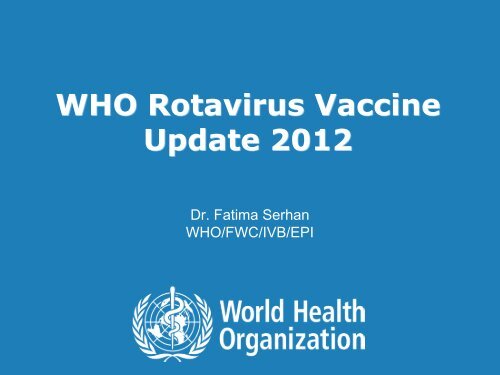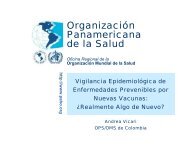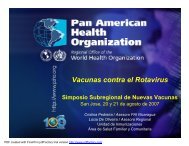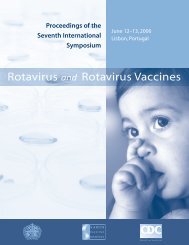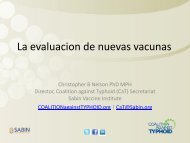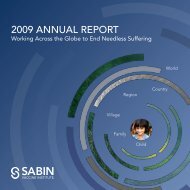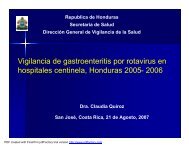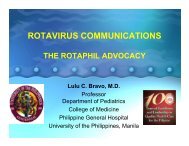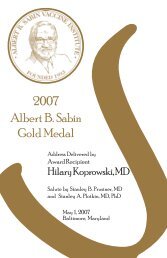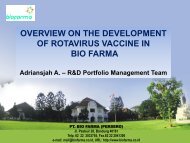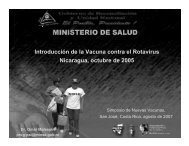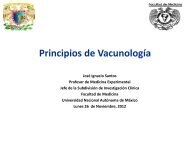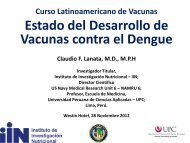10th International Rotavirus Symposium ... - Sabin Vaccine Institute
10th International Rotavirus Symposium ... - Sabin Vaccine Institute
10th International Rotavirus Symposium ... - Sabin Vaccine Institute
Create successful ePaper yourself
Turn your PDF publications into a flip-book with our unique Google optimized e-Paper software.
WHO <strong>Rotavirus</strong> <strong>Vaccine</strong><br />
Update 2012<br />
Dr. Fatima Serhan<br />
WHO/FWC/IVB/EPI
WHO estimates that 453 000 child deaths<br />
occurred during 2008 due to rotavirus infection<br />
41057<br />
32653<br />
82% of these deaths occurred in 20 countries<br />
2 | 10 th <strong>International</strong> <strong>Rotavirus</strong> <strong>Symposium</strong>, Bangkok, September 2012<br />
39144<br />
98621
40 Countries Have Introduced <strong>Rotavirus</strong> <strong>Vaccine</strong>s by<br />
2012<br />
Data Source: Joint Reporting Form, 2011 and NUVI<br />
database<br />
Map production: Immunization <strong>Vaccine</strong>s and<br />
Biologicals, (IVB), World Health Organization<br />
Date of slide: 11 September 2012<br />
* Includes partial introductions<br />
Introduced* (40 countries or 21%)<br />
3 | 10 th <strong>International</strong> <strong>Rotavirus</strong> <strong>Symposium</strong>, Bangkok, September 2012<br />
Planned introduction in 2012 (10 countries or 5%)<br />
Planned introduction in 2013 (6 countries or 3%)<br />
Not Introduced (138 countries or 71%)<br />
Not applicable<br />
0 850 1,700 3,400 Kilometers<br />
The boundaries and names shown and the designations used on this map do not<br />
imply the expression of any opinion whatsoever on the part of the World Health<br />
Organization concerning the legal status of any country, territory, city or area or<br />
of its authorities, or concerning the delimitation of its frontiers or boundaries.<br />
Dotted lines on maps represent approximate border lines for which there may not<br />
yet be full agreement.<br />
� WHO 2012. All rights reserved
Countries that participated in 2011 WHO surveillance<br />
network with data reported each period and >100<br />
children enrolled<br />
Data Source: Joint Reporting Form, 2011 and NUVI<br />
database<br />
Map production: Immunization <strong>Vaccine</strong>s and<br />
Biologicals, (IVB), World Health Organization<br />
Date of slide: 11 September 2012<br />
* Includes partial introductions<br />
Introduced* (40 countries or 21%)<br />
4 | 10 th <strong>International</strong> <strong>Rotavirus</strong> <strong>Symposium</strong>, Bangkok, September 2012<br />
0 1,700 3,400<br />
850 Kilometers<br />
Countries reporting every month and more than 100 specimens tested (42<br />
countries)<br />
Planned introduction in 2012 (10 countries or 5%)<br />
Planned introduction in 2013 (6 countries or 3%)<br />
Not Introduced (138 countries or 71%)<br />
Not applicable<br />
The boundaries and names shown and the designations used on this map do not<br />
imply the expression of any opinion whatsoever on the part of the World Health<br />
Organization concerning the legal status of any country, territory, city or area or<br />
of its authorities, or concerning the delimitation of its frontiers or boundaries.<br />
Dotted lines on maps represent approximate border lines for which there may not<br />
yet be full agreement.<br />
� WHO 2012. All rights reserved
WHO <strong>Rotavirus</strong> surveillance Network , 2011<br />
64 countries<br />
185 sentinel sites<br />
Source: WHO/IVB New <strong>Vaccine</strong>s database 58 Member States reported clinical data<br />
Data collected from WHO Regions.<br />
GRL/RRL<br />
CDC Atlanta<br />
RRL/<br />
Brazil<br />
RRL/<br />
Ghana<br />
RRL/<br />
South Africa<br />
5 | 10 th <strong>International</strong> <strong>Rotavirus</strong> <strong>Symposium</strong>, Bangkok, September 2012<br />
RRL/<br />
Belarus<br />
RRL/<br />
Egypt<br />
RRL/<br />
Kenya<br />
RRL/<br />
India<br />
Number of Children
Annual <strong>Rotavirus</strong> Detection (2011): Criteria<br />
� Countries with > 100 specimens tested<br />
� Countries with specimens tested for each month to ensure information<br />
available for each season (seasonal variation in rotavirus disease)<br />
6 | 10 th <strong>International</strong> <strong>Rotavirus</strong> <strong>Symposium</strong>, Bangkok, September 2012<br />
WPR 53%<br />
EUR 37%<br />
EMR 40%<br />
AMR 20%<br />
AFR 40%<br />
SEAR data<br />
pending, no global<br />
median
Example of <strong>Rotavirus</strong> Detection in Member State that has<br />
Introduced <strong>Rotavirus</strong> <strong>Vaccine</strong><br />
<strong>Vaccine</strong> introduced in 2007<br />
n=<br />
1907<br />
n=<br />
1900<br />
n=<br />
1994<br />
n= tested<br />
n=<br />
2215<br />
7 | 10 th <strong>International</strong> <strong>Rotavirus</strong> <strong>Symposium</strong>, Bangkok, September 2012<br />
<strong>Vaccine</strong> introduced in 2006<br />
n=705<br />
n=852<br />
n= tested<br />
n=779
8 | 10 th <strong>International</strong> <strong>Rotavirus</strong> <strong>Symposium</strong>, Bangkok, September 2012<br />
Percent Distribution of <strong>Rotavirus</strong> Genotypes among<br />
specimens typed by Country (n=4,736), 2011
Making the most of<br />
rotavirus<br />
immunization
Previously recommended <strong>Rotavirus</strong> immunization<br />
<strong>Vaccine</strong><br />
Rotarix<br />
RV1<br />
Rota Teq<br />
RV5<br />
Age at 1st<br />
dose<br />
6 weeks (min)<br />
with DTP1<br />
15 weeks (max)<br />
6 weeks (min)<br />
with DTP1<br />
15 weeks (max)<br />
schedule (2009)<br />
No.<br />
Doses<br />
10 | 10 th <strong>International</strong> <strong>Rotavirus</strong> <strong>Symposium</strong>, Bangkok, September 2012<br />
2<br />
3<br />
Interval<br />
1st to 2 nd<br />
dose<br />
4 weeks (min)<br />
with DTP2<br />
No later than<br />
32 weeks of<br />
age<br />
4 weeks (min)<br />
with DTP2<br />
Interval<br />
2nd to 3 rd<br />
dose<br />
4 weeks (min)<br />
with DTP3<br />
No later than<br />
32 weeks of<br />
age
SAGE critically reviewed new evidence with<br />
the aim of assessing if additional deaths<br />
could be prevented (April 2012)<br />
epidemiology in young children from more than 30<br />
countries<br />
vaccine efficacy and effectiveness of different<br />
immunization schedules in different settings;<br />
improved estimates of actual age at vaccination,<br />
coverage and the benefits in different<br />
epidemiological settings;<br />
and revised estimates of the risk of intussusception<br />
after rotavirus vaccination.<br />
11 | 10 th <strong>International</strong> <strong>Rotavirus</strong> <strong>Symposium</strong>, Bangkok, September 2012
<strong>Rotavirus</strong> <strong>Vaccine</strong>: Optimizing Schedules<br />
SAGE – April 2012 meeting<br />
SAGE was informed by separate reviews by:<br />
the Global Advisory Committee on <strong>Vaccine</strong><br />
Safety<br />
the Immunization Practice Advisory<br />
Committee and<br />
An ad-hoc <strong>Rotavirus</strong> experts consultation.<br />
12 | 10 th <strong>International</strong> <strong>Rotavirus</strong> <strong>Symposium</strong>, Bangkok, September 2012
Immunizing children against rotavirus:<br />
Making the most of every contact<br />
Malawi<br />
13 | 10 th <strong>International</strong> <strong>Rotavirus</strong> <strong>Symposium</strong>, Bangkok, September 2012
To maximize its impact rotavirus vaccine has to<br />
be given before <strong>Rotavirus</strong> Gastro-Enteritis occur<br />
% of all cases aged < 60 months occurring<br />
each week<br />
2.5%<br />
2.0%<br />
1.5%<br />
1.0%<br />
0.5%<br />
15 weeks<br />
32 weeks<br />
Hospital admisions due to <strong>Rotavirus</strong><br />
Gastro-Enteritis in Malawi<br />
14 | <strong>10th</strong> 0.0%<br />
0 26 52 78 104 130 156<br />
Source: Turner <strong>International</strong> et al <strong>Rotavirus</strong> <strong>Symposium</strong>, Bangkok, September 2012<br />
Analysis by Sanderson C et al (2011)<br />
age in weeks
It is critical to administer each dose of vaccine at<br />
the recommended age & to achieve high coverage<br />
100%<br />
80%<br />
60%<br />
40%<br />
20%<br />
Source:<br />
DHS5<br />
0%<br />
Coverage based on DHS5 survey data:<br />
Malawi 2007-10<br />
15 weeks<br />
32 weeks<br />
0 26 52 78 104<br />
age in weeks<br />
15 | 10 th <strong>International</strong> <strong>Rotavirus</strong> <strong>Symposium</strong>, Bangkok, September 2012<br />
1 dose Analysis 2 doses by: Sanderson C, 3 Clark doses et al 2012
% coverage<br />
<strong>Rotavirus</strong> vaccine coverage needs to be high among<br />
children at higher risk of rotavirus infection and death.<br />
100%<br />
80%<br />
60%<br />
40%<br />
20%<br />
0%<br />
Analysis by Sanderson C et al 2012<br />
Malawi DHS 2007-9: DTP1<br />
by age and wealth quinttile<br />
15 weeks<br />
0 5 10 15 20 25 30 35 40 45 50<br />
age in weeks<br />
poorest poorer middle richer richest<br />
16 | 10 th <strong>International</strong> <strong>Rotavirus</strong> <strong>Symposium</strong>, Bangkok, September 2012<br />
32 weeks
Immunization<br />
schedule<br />
The benefits of rotavirus vaccine<br />
outweigh the potential risks<br />
Potential<br />
vaccine associated<br />
intussusception<br />
deaths<br />
Age restricted 288<br />
No age<br />
restriction<br />
Difference<br />
453,000 deaths due to rotavirus infection globally<br />
(99 to 688)*<br />
605<br />
(310 to 1,133)*<br />
317<br />
additional<br />
vaccine associated IS<br />
deaths<br />
(211 to 445)<br />
Median (5 th and 95 th percentiles)<br />
Estimated<br />
rotavirus deaths<br />
averted<br />
156,100<br />
(110,100 to 201,800)<br />
199,200<br />
(140,700 to 255,400)<br />
43,100<br />
additional<br />
rotavirus<br />
deaths<br />
(30,600 to 53,500)<br />
Source: Patel M, Clark A et al 2012)
Recommendations<br />
SAGE – April 2012 meeting<br />
The risk benefit analysis continues to<br />
favour rotavirus vaccination<br />
The previous age restrictions for the first<br />
dose (=
Recommendations<br />
SAGE – April 2012 meeting<br />
By removing age restrictions, programmes will be<br />
able to immunize children who are currently<br />
excluded from the benefits of rotavirus vaccines and<br />
this is likely to include some of the children most<br />
vulnerable to severe rotavirus disease.<br />
Many thousands more deaths would be averted, but<br />
with a small additional increase in intussusception<br />
cases.<br />
19 | 10 th <strong>International</strong> <strong>Rotavirus</strong> <strong>Symposium</strong>, Bangkok, September 2012
SAGE – April 2012 meeting<br />
<strong>Rotavirus</strong> <strong>Vaccine</strong>: Optimizing Schedules<br />
Recommendations<br />
SAGE also noted that in view of the age<br />
distribution of rotavirus disease, providing rotavirus<br />
vaccine to children older than 24 months of age<br />
will be of little benefit.<br />
20 | 10 th <strong>International</strong> <strong>Rotavirus</strong> <strong>Symposium</strong>, Bangkok, September 2012
SAGE – April 2012 meeting<br />
<strong>Rotavirus</strong> <strong>Vaccine</strong>: Optimizing Schedules<br />
Recommendations<br />
SAGE continues to recommend that<br />
the first dose of rotavirus vaccine be<br />
administered along with DTP doses,<br />
as soon as possible after 6 weeks of<br />
age as this maximizes disease<br />
protection.<br />
21 | 10 th <strong>International</strong> <strong>Rotavirus</strong> <strong>Symposium</strong>, Bangkok, September 2012
SAGE – April 2012 meeting<br />
<strong>Rotavirus</strong> <strong>Vaccine</strong>: Optimizing Schedules<br />
Recommendations<br />
SAGE recognized that countries have<br />
� different burdens of disease and<br />
� may or may not have introduced rotavirus<br />
vaccines.<br />
For this reason, countries should develop country-specific<br />
plans on how the removal of age restrictions on vaccine<br />
administration can be introduced in a manner that<br />
supports existing programmes.<br />
22 | 10 th <strong>International</strong> <strong>Rotavirus</strong> <strong>Symposium</strong>, Bangkok, September 2012
SAGE – April 2012 meeting<br />
<strong>Rotavirus</strong> <strong>Vaccine</strong>: Optimizing Schedules<br />
Recommendations<br />
SAGE requests WHO to develop tools to support<br />
country decision-making and<br />
where possible National Immunization Technical<br />
Advisory Groups (NITAGs) and<br />
Regional Technical Advisory Groups (RTAGs)<br />
should assist this process.<br />
23 | 10 th <strong>International</strong> <strong>Rotavirus</strong> <strong>Symposium</strong>, Bangkok, September 2012
SAGE – April 2012 meeting<br />
<strong>Rotavirus</strong> <strong>Vaccine</strong>: Optimizing Schedules<br />
Recommendations<br />
Due to the small risk of intussusception after<br />
rotavirus vaccine administration,<br />
caregivers should be informed of this risk and<br />
be adequately counselled to recognize early<br />
signs of intussusception, and<br />
encouraged to present cases immediately for<br />
medical attention.<br />
24 | 10 th <strong>International</strong> <strong>Rotavirus</strong> <strong>Symposium</strong>, Bangkok, September 2012
SAGE – April 2012 meeting<br />
<strong>Rotavirus</strong> <strong>Vaccine</strong>: Optimizing Schedules<br />
Recommendations<br />
SAGE recognized that a comprehensive<br />
communication strategy that explains the reasons<br />
for this change of schedules should be developed<br />
and made available to all stakeholders including<br />
policymakers, programme managers,<br />
communities and parents, and requested WHO to<br />
develop appropriate tools.<br />
25 | 10 th <strong>International</strong> <strong>Rotavirus</strong> <strong>Symposium</strong>, Bangkok, September 2012
SAGE – April 2012 meeting<br />
Implementing the recommendations<br />
Global evidence used to inform SAGE recommendation http://perso.epita.fr/~costa_k/<strong>Rotavirus</strong>ProjectVersion2/<br />
26 | 10 th <strong>International</strong> <strong>Rotavirus</strong> <strong>Symposium</strong>, Bangkok, September 2012
To maximize rotavirus vaccine impact<br />
• <strong>Vaccine</strong> has to be given before <strong>Rotavirus</strong> Gastro-Enteritis<br />
(RVGE) occurs.<br />
• It is critical to administer the 1 st dose at 6 weeks or soon<br />
thereafter<br />
• <strong>Vaccine</strong> coverage needs to be high, specially among<br />
children at higher risk of rotavirus death and in poor<br />
settings.<br />
• The benefits of rotavirus vaccine (estimated RVGE deaths<br />
averted) outweighs the risks (potential intussusception<br />
deaths associated with rotavirus vaccine).<br />
27 | 10 th <strong>International</strong> <strong>Rotavirus</strong> <strong>Symposium</strong>, Bangkok, September 2012
To ensure adequate implementation of these<br />
SAGE recommendations countries should:<br />
• Develop country-specific plans on how rotavirus vaccine<br />
can be introduced in a manner that strengthen existing<br />
immunization programmes.<br />
• Enrich and contrast global data with other locally<br />
relevant data<br />
• Use NITAG members, decision makers at the national<br />
immunization programme and other key stakeholders to<br />
review and discuss this data together with any other<br />
available evidence.<br />
28 | 10 th <strong>International</strong> <strong>Rotavirus</strong> <strong>Symposium</strong>, Bangkok, September 2012
� WHO pre-qualified vaccines<br />
Information Resources<br />
– http://www.who.int/immunization_standards/vaccine_quality/pq_suppliers/<br />
en/index.html<br />
� <strong>Vaccine</strong> introduction guidelines<br />
– http://www.who.int/nuvi/<strong>Vaccine</strong>_intro_resources/en/index.html<br />
� <strong>Rotavirus</strong> vaccine resources<br />
– http://www.who.int/nuvi/rotavirus/en/index.html<br />
� Global evidence used to inform SAGE recommendation<br />
– http://perso.epita.fr/~costa_k/<strong>Rotavirus</strong>ProjectVersion2/<br />
29 | 10 th <strong>International</strong> <strong>Rotavirus</strong> <strong>Symposium</strong>, Bangkok, September 2012
TODAY's evidence comes from…<br />
RCTs (20 countries)<br />
Observational studies (11 countries)<br />
Epidemiology data (29 countries)<br />
30 | 10 th <strong>International</strong> <strong>Rotavirus</strong> <strong>Symposium</strong>, Bangkok, September 2012<br />
The boundaries and names shown and the designations used on this map do not<br />
imply the expression of any opinion whatsoever on the part of the World Health<br />
Organization concerning the legal status of any country, territory, city or area or of<br />
its authorities, or concerning the delimitation of its frontiers or boundaries. Dotted<br />
lines on maps represent approximate border lines for which there may not yet be<br />
full agreement.<br />
� WHO 2011 All rights reserved
ACKNOWLEDGEMENTS<br />
Andrew Clark


